By June Yasuhara
SAN JOSE, CA – There’s been a special project that has been brewing in a San Jose garage turned workshop since April 2024 and now it’s ready for it’s BIG reveal! I was privileged to be invited to view the work in progress in April of 2025.
Rory Fukuda has been meticulously creating a miniature replica of a portion of San Jose Japantown, a place that Rory grew up and has many connections to the business owners and residents. He describes it as a 2024 snapshot of 5th and Jackson Street, the center of Japantown.
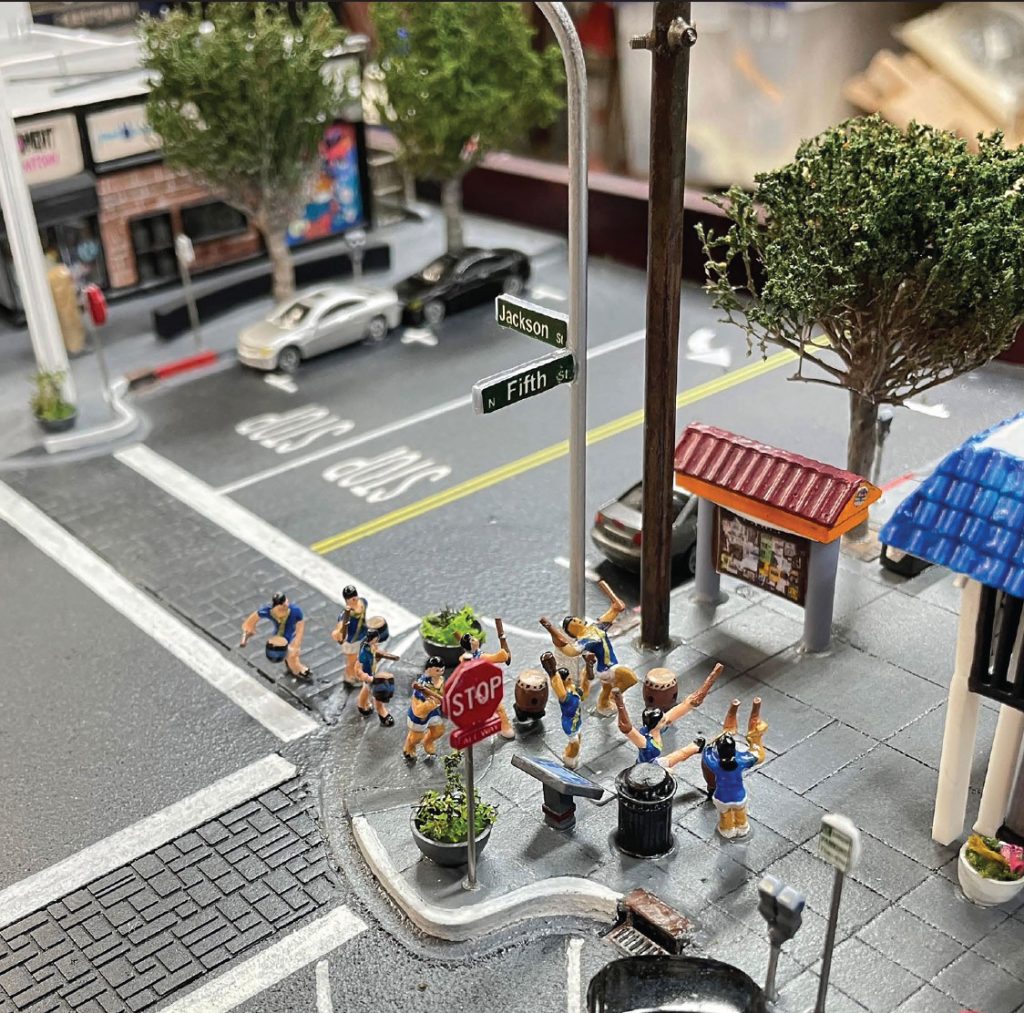
The former design drafter of a water company’s engineering department drafted all the line work drawing by hand in 1984 before computers were available to do so. All his working experience came in handy when he retired and began creating countless projects.
When cruising around San Jose Japantown, you may come across Rory’s imprint without realizing it. A gate that is a part of Roy’s Station Coffee and Tea, was refinished and family mons were carved into them by Rory. He also built a bench that sits in front of the Coldwater store with a koi fish engraving. Not visible are steam boxes that Rory started making 8 years ago for Shuei-Do Manju Shop owner, Tom Kumamaru. Tom used to buy “seiro” – steam boxes from Japan to make their highly sought out manju with. When Rory found this out, he offered to try to make boxes. They worked out great and he gets a call every couple of years from Tom who asks for replacements.
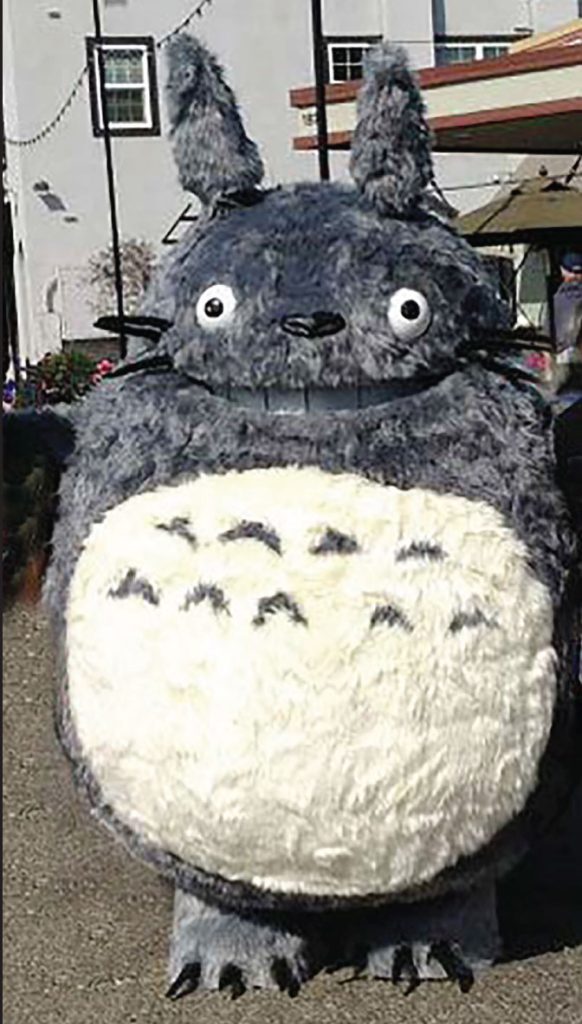
Rory’s Totoro creation complete with a mouth and hands that are mechanically rigged to move.
Rory loves a challenge. In 2008, he discovered cosplay and the world of anime. He saw a Totoro costume that looked like a sack of potatoes, so he decided to make one himself that looks more like Totoro and has various working parts! The whole process is documented on YouTube. com! If you’ve been at the Nikkei Matsuri, you may have seen it!
About 12 years ago, Rory discovered 3D printers. He thought they were cool and bought his first one, a FDM (fused deposition modeling) printer. He experimented making figurine models, but Rory commented thatthe quality was not very good and he spent time sanding and finishing the edges. He also has a CNC (computer numerical control) machine as a part of his creative arsenal which he can carve and engrave with.
About 2 years ago, Rory used his machines and his talent to create models of businesses that are part of the San Jose Japantown neighborhood. Hukilau Restaurant, Jack’s Bar, San Jose Buddhist church, Kay’s Shisedo, Santo Market, Nijiya Market, Corona Restaurant, Higashi Building, Roy’s Station Coffee & Tea, J-town Pizza, San Jose Japanese American Museum, the Shanghai building with Kaita Restaurant, Shuei-do Manju, Nikkei Traditions and State of Grace Tattoo were some of the major models he created and then gave away to the San Jose Japanese American Museum. He made them “just for fun”! He then purchased a resin printer, which prints his creations with really fine details and was anticipating tackling his next big project.
Since Rory had the specs for those models, he decided to make a new collection of some of those models and add additional buildings to create a major part of the town focusing on the area that intersects with Jackson Street and 5th Street. “No one has ever preserved Japantown this way”, Rory explains when asked what his intention was when he decided to create the replica. “Most history you see are in pictures, books, film, but not like this. Tsugaru Restaurant was in the process of being renovated as a bakery, so I thought, ahhhh… let’s capture that restaurant before it goes away!”
The first thing that had to be done, was figure out the scale. Rory had to test his 3D printer to see how small it could print without losing detail. He made Roy’s Station patio furniture and railing. Also, he added a figurine of PJ Hirabayashi, a founding member of San Jose Taiko. When he figured out his printer can do a certain scale, he then had to figure out how big to make the model.
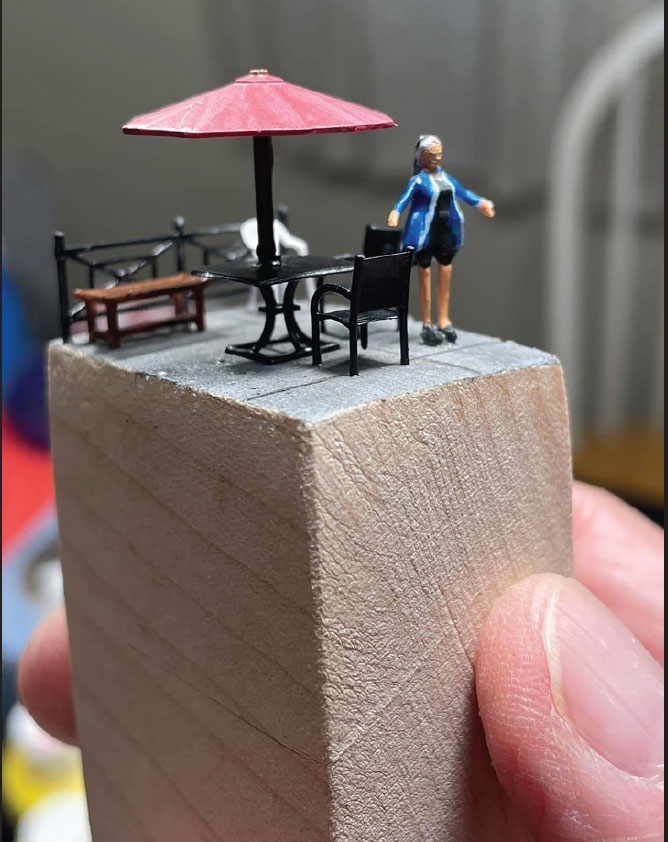
Initially, he wanted to create the neighborhood from 4th Street to 6th Street. One end to include Wesley Methodist Church and the Issei Building all the way to the San Jose Buddhist Church and Lotus Preschool on the other end, but with this scale, it would have been a “monster of a model” as Rory chuckles. The cutting line ended up fitting Tsugaru Restaurant with the Shanghai building across the way on Jackson Street down to the other end of Jackson where San Jose Tofu was and across the way where The J. Morey Company stands.
“There weren’t scaled measurements” explains Rory. “It’s guess work. It’s not exact, but very close.” He uses google earth and an arial photo to make the best guess estimate for measurements to get a plan layout of the buildings. Once he has an outline of the buildings, he then uses 3D programming on the computer and stretch up the buildings and he guesses the height relations of the buildings.
The first physical component to be made was the base which is made from particle board. Holes are cut for the various outlets for the fiber optic lighting which will illuminate the inside of buildings, street lights, decorative lighting and the monument light. All the sidewalk lines, gutters and the planter squares were then carved out. The street markings and curbs are then hand painted. The cobbled crosswalks, also carved out by the 3D printer, finished off the streets.
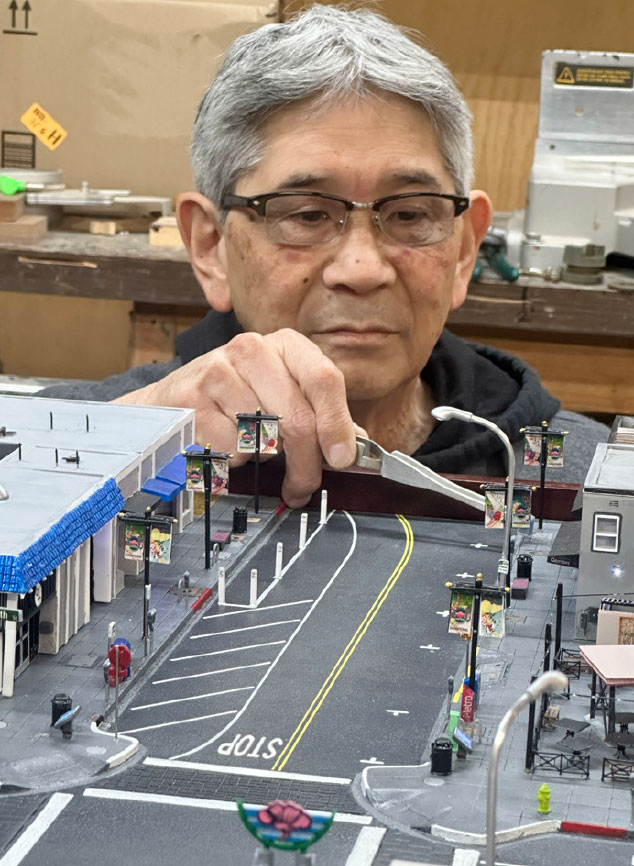
Next, the buildings are created front to back. They are then meticulously hand painted to match their landmark. Once the building placements have been decided, the specific details such as where the street signs, pots, fire hydrant, garbage cans, parking meters, benches from what Rory physically observes while walking the streets are planned out.
The creative genius has worked on this project almost every day averaging 2 – 6 hours depending if he’s into it or not. If he is really into a building, he may want to work on it until it’s finished. At the time I visited, he was working on trees and the potted plants and said he averages about 2-3 trees a day and a few potted plants thrown in. There are 67 planters around 5th and Jackson and 20 trees. It took him 3 hours to make the bonsai trees.
When asked what his favorite part of the process was, Rory shared that it was figuring out the challenges. How to make the store sign light up at night to how to make realistic looking trees were just a few of the problem solving issues he enjoyed and found pride in.
He projected mid or end of May for his model to be completed. I followed him on Facebook to watch his progress and when he made vehicles and people, I knew he was close. On May 18th, he posted his completed project after he installed the acrylic protective cover. The final location of the model is yet to be determined.
I hope Rory realizes the impact that his “fun project for him” will be for the community and future generations. This replica that mirrors a place in time and captures the essence of San Jose Japantown complete with historical shops and particular community members including San Jose Taiko strolling down the street, will be enjoyed by countless people from ones who grew up in J-town or ones who are visiting.
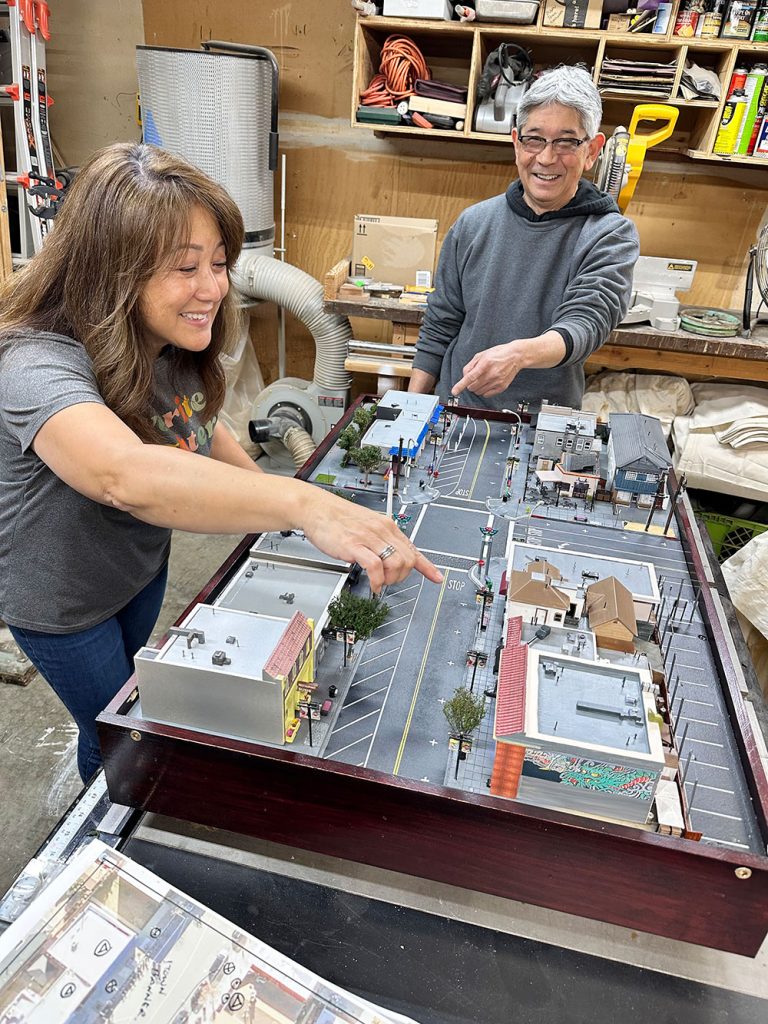
It will act as a unique way of preserving 2025, but at the same time will bring others to recount what was there. I found myself captivated by all the incredible details that Rory included to make it as authentic as possible. Rory is very humble and just giggled as I ‘ooh’d and ahh’d’ over all the fun things I was witnessing.
Having the model of Japantown to refer to, it turned out to be a perfect way to story tell. I pointed to where Kumako Ramen is and told him it’s where my mother worked when it was a coffee shop and she lived on the second story of that building. Rory, then showed us where his father and uncle owned a barber shop. Rory admitted that he does get a little depressed when he is finished with a project. He gets obsessed and has tunnel vision and all he sees is this model for the past year. When he hands over his project, he thinks, “now what?”
I reached out to congratulate him when I saw that his incredible town was completed. I was a little concerned for him as I didn’t want him to be sad, but I was happy (but not surprised) to hear that he already has a project in line, again for a Japantown business. He will be making kachi kachis for Nichi Bei Bussan for the upcoming Obon festival.


